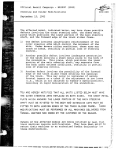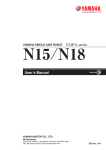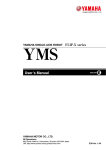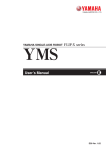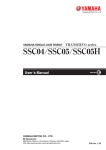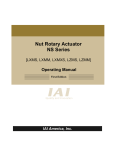Download User`s Manual - Yamaha Robotics
Transcript
AMAHA SINGLE-AXIS ROBOT T4/T4H T5/T5H FLIP-X series User’s Manual ENGLISH E YAMAHA MOTOR CO., LTD. IM Operations 882 Soude, Naka-ku, Hamamatsu, Shizuoka 435-0054.Japan URL http://www.yamaha-motor.jp/robot/index.html E18-Ver. 2.01 Contents Introduction Chapter 1 About Safety 1-1 1-2 Safety Information ............................................................... 1-3 Essential Caution Items ...................................................... 1-5 1-3 1-4 Industrial Robot Operating and Maintenance Personnel......1-10 Robot Safety Functions ..................................................... 1-11 1-5 1-6 Safety Measures for the System ....................................... 1-12 Trial Operation .................................................................... 1-12 1-7 1-8 Work Within the Safeguard Enclosure ............................. 1-13 Automatic Operation ......................................................... 1-13 1-9 Warranty .............................................................................. 1-14 Chapter 2 Installation and Connections 2-1 2-2 Checking the product .......................................................... 2-3 Robot part names ................................................................ 2-3 2-3 2-4 Robot Installation Conditions ............................................. 2-4 Installation base ................................................................... 2-5 2-5 2-6 Installing the robot ............................................................... 2-6 Connections ......................................................................... 2-8 2-6-1 Connecting the robot cables .................................................................... 2-8 2-6-2 System Configuration Example .............................................................. 2-9 2-7 2-8 About machine reference .................................................. 2-10 Duty ..................................................................................... 2-10 Chapter 3 Periodic Inspection 3-1 3-2 Before beginning work ........................................................ 3-3 Periodic inspection .............................................................. 3-5 3-2-1 Daily inspection ...................................................................................... 3-5 3-2-2 Three-month inspection .......................................................................... 3-5 3-2-3 Six-month inspection .............................................................................. 3-6 3-2-4 Three-year inspection .............................................................................. 3-6 3-3 3-4 Applying grease ................................................................... 3-7 Replacing the shutter .......................................................... 3-8 3-5 Adjusting shutter looseness ............................................. 3-10 Chapter 4 Specifications 4-1 Robot specifications ............................................................ 4-3 4-1-1 T4/T4H .................................................................................................... 4-3 4-1-2 T5/T5H .................................................................................................... 4-5 4-2 AC servo motor specifications ........................................... 4-7 4-2-1 AC servo motor termination .................................................................... 4-7 4-2-2 Brake cable specifications (vertical use) ................................................. 4-8 4-3 Robot cable .......................................................................... 4-9 Chapter 5 Troubleshooting 5-1 Positioning error .................................................................. 5-3 5-2 Feedback error ..................................................................... 5-4 Introduction The YAMAHA FLIP-X series is a family of single-axis industrial robots that use the absolute positioning method as a standard feature to improve ease of use, resistance to environmental conditions and maintenance work. A wide varaiety of product lineup allows you to select the desired robot model that best matches your application. This user’s manual describes the safety measures, handling, adjustment and maintenance of FLIP-X series robots for correct, safe and effective use. Be sure to read this manual carefully before installing the robot. Even after you have read this manual, keep it in a safe and convenient place for future reference. • This user's manual should be used with the robot and considered an integral part of it. When the robot is moved, transferred or sold, send this manual to the new user along with the robot. Be sure to explain to the new user the need to read through this manual. • Specifications of robot models other than standard models may be omitted in this manual if they are common to those of standard models. In this case, refer to the specifications of standard models. • For details on specific operation of the robot, refer to the separate user's manual for the robot controller being used. NOTES • The contents of this manual are subject to change without prior notice. • While every effort has been made to ensure the contents of this manual are correct, please contact us if you find any part of this manual to be unclear, confusing or inaccurate. YAMAHA MOTOR CO., LTD. IM Operations MEMO Chapter 1 About Safety 1-1 Safety Information ............................................................... 1-3 1-2 1-3 Essential Caution Items ...................................................... 1-5 Industrial Robot Operating and Maintenance Personnel .....1-10 1-4 1-5 Robot Safety Functions ..................................................... 1-11 Safety Measures for the System ....................................... 1-12 1-6 1-7 Trial Operation .................................................................... 1-12 Work Within the Safeguard Enclosure ............................. 1-13 1-8 1-9 Automatic Operation ......................................................... 1-13 Warranty .............................................................................. 1-14 MEMO 1-2 Chapter 1 About Safety 1-1 Safety Information Industrial robots are highly programmable, mechanical devices that provide a large degree of freedom when performing various manipulative tasks. To ensure correct and safe use of YAMAHA industrial robots, carefully read this manual and make yourself well acquainted with the contents. FOLLOW THE WARNINGS, CAUTIONS AND INSTRUCTIONS INCLUDED IN THIS MANUAL. Failure to take necessary safety measures or mishandling due to not following the instructions in this manual may result in trouble or damage to the robot and injury to personnel (robot operator or service personnel) including fatal accidents. Warning information in this manual is shown classified into the following items. DANGER Failure to follow DANGER instructions will result in severe injury or death to the robot operator, bystanders or persons inspecting or repairing the robot. WARNING Failure to follow WARNING instructions could result in severe injury or death to the robot operator, bystanders or persons inspecting or repairing the robot. CAUTION Failure to follow CAUTION instructions may result in injury to the robot operator, bystanders or persons inspecting or repairing the robot, or damage to the robot and/ or robot controller. NOTE Explains the key point in the operation in a simple and clear manner. 1-3 Chapter 1 About Safety Refer to the user's manual by any of the following methods to operate or adjust the robot safely and correctly. 1. Operate or adjust the robot while referring to the printed version of the user's manual (available for an additional fee). 2. Operate or adjust the robot while viewing the CD-ROM version of the user's manual on your computer screen. 3. Operate or adjust the robot while referring to a printout of the necessary pages from the CDROM version of the user's manual. It is not possible to list all safety items in detail within the limited space of this manual. So it is essential that the user have a full knowledge of basic safety rules and also that the operator makes correct judgments on safety procedures during operation. For specific safety information and standards, refer to the applicable local regulations and comply with the instructions. This manual and warning labels supplied with or attached to the robot are written in English. Unless the robot operators or service personnel understand English, do not permit them to handle the robot. * Cautions regarding the official language of EU countries For equipment that will be installed in EU countries, the language used for the user's manuals, CE declarations, and operation screen characters is English only. Warning labels only have pictograms or else include warning messages in English. In the latter case, Japanese messages might be added. 1-4 Chapter 1 About Safety 1-2 Essential Caution Items Particularly important cautions for handling or operating the robot are described below. In addition, safety information about installation, operation, inspection and maintenance is provided in each chapter. Be sure to comply with these instructions to ensure safe use of the robot. (1) Observe the following cautions during automatic operation. · Install a safeguard (protective enclosure) to keep any person from entering within the movement range of the robot and suffering injury due to being struck by moving parts. · Install a safety interlock that triggers emergency stop when the door or panel is opened. · Install safeguards so that no one can enter inside except from doors or panels equipped with safety interlocks. · The warning labels shown in Fig. 1-1 are supplied with the robot and should be affixed to conspicuous spots on doors or panels equipped with safety interlocks. DANGER Serious injury or death will result from impact with moving robot. · Keep outside of guard during operation. · Lock out power before approaching robot. DANGER Serious injury or death will result from impact with moving robot. • Keep outside of guard during operation. • Lock out power before approaching robot. Fig. 1-1 Warning label 1 (2) Use caution to prevent hands or fingers from being pinched or crushed. Warning labels 2 (Fig. 1-2) are affixed to the robot. WARNING Moving parts can pinch or crush. Keep hands away from robot arms. WARNING Moving parts can pinch or crush. Keep hands away from robot arms. Fig. 1-2 Warning label 2 1-5 Chapter 1 About Safety (3) Follow the instructions on listed on warning labels and in this manual. · Be sure to read the warning labels and this manual carefully and make sure you thoroughly understand their contents before attempting installation and operation of the robot. · Before starting robot operation, be sure to reread the procedures and cautions relating to your work as well as descriptions in this chapter (Chapter 1, “About Safety”). · Never install, adjust, inspect or service the robot in any manner that does not comply with the instructions in this manual. · The warning labels shown in Fig. 1-3 are supplied with the robot and should be affixed to the robot or conspicuous spots near the robot. WARNING Improper installation or operation can result in serious injury or death. Read the user’s manual and all warning labels before operation. WARNING Improper Installation or operation can result in serious injury or death. Read user's(owner's) manual and all warning labels before operation. Fig. 1-3 Warning label 3 (4) Do not remove, alter or stain the warning labels. WARNING If warning labels are removed or difficult to see, then essential precautions might not be taken, resulting in accidents. · Do not remove, alter or stain the warning labels on the robot. · Do not allow the warning labels to be hidden by devices installed onto the robot by the user. · Provide proper lighting so that the symbols and instructions on the warning labels can be clearly seen even from outside the safeguard enclosure. (5) Do not use the robot in environments containing inflammable gas, etc. WARNING · This robot was not designed for operation in environments where inflammable or explosive substances are present. · Do not use the robot in environments containing inflammable gas, dust or liquids. Explosions or fire might otherwise result. (6) Do not use the robot in locations possibly subject to electromagnetic interference, etc. WARNING Avoid using the robot in locations subject to electromagnetic interference, electrostatic discharge or radio frequency interference. Malfunctions might otherwise occur. 1-6 Chapter 1 About Safety (7) Use caution when releasing the brake of a vertical use robot. WARNING The vertical axis will slide down when the brake is released, causing a hazardous situation. · Press the emergency stop button and prop up the vertical axis with a support stand before releasing the brake. · Be careful not to let your body get caught between the vertical axis and installation base when releasing the brake to perform direct teach. (8) Provide safety measures for end effector (gripper, etc.). WARNING · End effectors must be designed and manufactured so that they create no hazards (for example, a workpiece that comes loose) even if power (electricity, air pressure, etc.) is shut off or power fluctuations occur. · If there is a possible danger that the object gripped by the end effector may fly off or drop, then provide appropriate safety protection taking into account the object size, weight, temperature and chemical properties. (9) Use caution when removing the motor. (Vertical use robots) WARNING The vertical axis will slide down when the motor is released, causing a hazardous situation. · Turn off the robot controller and prop up the vertical axis with a support stand before removing the motor. · Be careful not to let your body get caught between the vertical axis parts and installation base. (10) Be careful not to touch the motor or speed reduction gear casing when hot. WARNING The motor and speed reduction gear casing are extremely hot after automatic operation, so burns may occur if these are touched. Before handling these parts during inspection or servicing, turn off the controller, wait for a while and check that the part has cooled. (11) Take the following safety precautions during inspection of controller. WARNING · When you need to touch the terminals or connectors on the outside of the controller during inspection, always first turn off the controller power switch and also the power source in order to prevent possible electrical shock. · Never touch any internal parts of the controller. · Refer to the “YAMAHA Robot Controller User’s Manual” for precautions on handling the controller. 1-7 Chapter 1 About Safety (12) Use caution not to touch the controller cooling fan. WARNING · Bodily injury may occur from coming into contact with the cooling fan while it is rotating. · When removing the fan cover for inspection, first turn off the controller and make sure the fan has stopped. (13) Consult us for corrective action when the robot is damaged or malfunctions occur. WARNING If any part of the robot is damaged or any malfunction occurs, continuing the operation may be very dangerous. Please consult your YAMAHA sales office or dealer for corrective action. Damage or Trouble Possible Danger Damage to machine harness or robot cable Electrical shock, malfunction of robot Damage to exterior of robot Flying outwards of damaged parts during robot operation Abnormal operation of robot (positioning error, excessive vibration, etc.) Malfunction of robot Z-axis brake trouble Dropping of load (14) Protective bonding WARNING Be sure to ground the robot and controller to prevent electrical shock. (15) Be sure to make correct parameter settings. CAUTION The robot must be operated with correct acceleration coefficients according to the tolerable moment of inertia and manipulator tip mass or moment of inertia. If these are not correct, drive unit service life may end prematurely, and damage to robot parts or residual vibration during positioning may result. (16) Follow the specified procedures when installing, adjusting or inspecting the robot. WARNING Always follow the specified procedures when installing, adjusting or inspecting the robot. Never attempt any procedure not described in this manual. (17) Do not attempt any repair, parts replacement and modification. WARNING Do not attempt any repair, parts replacement and modification unless described in this manual. These works require technical knowledge and skill, and may also involve work hazards. 1-8 Chapter 1 About Safety (18) Location for installing the controller and the programming box or Handy Terminal The robot controller, programming box, and Handy Terminal should be installed at a location that is outside the robot movement range yet where it is easy to operate and view the robot performing tasks. (19) Protect electrical wiring and hydraulic/pneumatic hoses as needed. Install a cover or similar item to protect the electrical wring and hydraulic/pneumatic hoses from possible damage. (20) Install an operation status light. Install an operation status light (signal light tower, etc.) at an easy-to-see position so the operator will know whether the robot is merely stopped or is in emergency-error stop. (21) Clean work tools, etc. Work tools such as welding guns and paint nozzles which are mounted in the robot arm will preferably be cleaned automatically. (22) Provide adequate lighting. Make sure to provide enough lighting to ensure safety during work. (23) Prevent the gripped object from flying outwards. If the object or workpiece gripped by the robot might fly outward or drop and create a hazard to the operator, then protective equipment should be installed by taking the size, weight, temperature and chemical properties of the object into account. (24) Draw up "work instructions" and makes sure the operator learns them well. Decide on "work instructions" for the following items in cases where personnel must work within the robot movement range to perform teaching, maintenance or inspection. Make sure the workers know these "work instructions" well. (1) Robot operating procedures needed for tasks such as startup procedures and handling switches (2) Robot speeds used during tasks such as teaching (3) Methods for workers to signal each other when two or more workers perform tasks (4) Steps that the worker should take when a problem or emergency occurs (5) Steps to take after the robot has come to a stop when the emergency stop device was triggered, including checks for cancelling the problem or error state and safety checks in order to restart the robot. (6) In cases other than above, the following actions should be taken as needed to prevent hazardous situations due to sudden or unexpected robot operation or faulty robot operation, as listed below. 1. Show a display on the operator panel 2. Ensure the safety of workers performing tasks within the robot movement range 3. Clearly specify position and posture during work Position and posture where worker can constantly check robot movements and immediately move to avoid trouble if an error/problem occurs 4. Install noise prevention measures 5. Use methods for signaling operators of related equipment 6. Use methods to decide that an error has occurred and identify the type of error Implement the "work instructions" according to the type of robot, installation location, and type of work task. When drawing up the "work instructions", make an effort to include opinions from the workers involved, equipment manufacture's technicians, and workplace safety consultants, etc. (25) Display a sign on operation panel during work Display an easy to understand sign or message on the programming box, Handy Terminal, and operation panel during the job task, to prevent anyone other than the operators for that job task from mistakenly operating a start or selector switch. If needed, take other measures such as locking the cover on the operation panel. 1-9 Chapter 1 About Safety (26) Make daily and periodic inspections. (1) Always make sure that daily and periodic inspections are performed, and make a prework check to ensure there are no problems with the robot or related equipment. If a problem or abnormality is found, then promptly repair it or take other measures as necessary. (2) When you make periodic inspections or repairs, make a record and store it for at least 3 years. 1-3 Industrial Robot Operating and Maintenance Personnel Operators or persons who handle the robot such as for teaching, programming, movement check, inspection, adjustment, and repair must receive appropriate training and also have the skills needed to perform the job correctly and safely. They must read the user's manual carefully to understand its contents before attempting the robot operation. Tasks related to industrial robots (teaching, programming, movement check, inspection, adjustment, repair, etc.) must be performed by qualified persons who meet requirements established by local regulations and safety standards for industrial robots. 1-10 Chapter 1 About Safety 1-4 Robot Safety Functions (1) Overload detection This function detects an overload applied to the motor and shuts off the servo power. (2) Overheat detection This detects an abnormal temperature rise in the controller driver and shuts off the servo power. If an overload or overheat error occurs, take the following measures. 1.Insert a timer in the program. 2.Reduce the acceleration coefficient. (3) Soft limits Soft limits can be set on each axis to limit the working envelope in manual operation after return-to-origin and during automatic operation. Note: The working envelope is the area limited by soft limits. WARNING Soft limits must be set within the movement range (mechanical stopper). If the soft limit is set outside the movement range, the robot axis may collide with the mechanical stopper at high speed, causing the object gripped by the end effector to fly or drop and the robot to malfunction. (4) Mechanical stoppers If the servo power is suddenly shut off during high-speed operation by emergency stop or safety functions, these mechanical stoppers prevent the axis from exceeding the movement range. No mechanical stopper is provided on the rotating axis. Note: The movement range is the area limited by mechanical stoppers. WARNING Axis movement will not stop immediately after the servo power supply is shut off by emergency stop or other safety functions. (5) Vertical axis brake An electromagnetic brake is installed on the vertical use robot to prevent the vertical axis from sliding down when servo power is turned off. This brake is working when the controller is off or the vertical axis servo power is off even when the controller is on. The vertical axis brake can be released by means of the programming box or by a command in the program when the controller is on. WARNING The vertical axis will slide down when the brake is released, creating a hazardous situation. · Press the emergency stop button and prop the vertical axis with a support stand before releasing the brake. · Use caution not to let your body get caught between the vertical axis and installation base when releasing the brake to perform direct teach. 1-11 Chapter 1 About Safety 1-5 Safety Measures for the System Since the robot is commonly used in conjunction with an automated system, dangerous situations are more likely to occur from the automated system than from the robot itself. Accordingly, appropriate safety measures must be taken on the part of the system manufacturer according to the individual system. The system manufacturer should provide a proper instruction manual for safe, correct operation and servicing of the system. 1-6 Trial Operation After making installations, adjustments, inspections, or maintenance or repairs to the robot, make a trial run using the following procedures. (1) If a safeguard enclosure has not yet been provided right after installation of the robot, rope off or chain off around the movement area of the manipulator in place of the safeguard, and observe the following points. 1. Use sturdy, stable posts which will not fall over easily. 2. The rope or chain should be easily visible by everyone around the robot. 3. Place a sign to keep the operator or other personnel from entering the movement range of the manipulator. (2) Check the following points before turning on the controller. 1. Is the robot securely and correctly installed? 2. Are the electrical connections to the robot correct? 3. Are items such as air pressure correctly supplied? 4. Is the robot correctly connected to peripheral equipment? 5. Have safety measures (safeguard enclosure, etc.) been taken? 6. Does the installation environment meet the specified standards. (3) After the controller is turned on, check the following points from outside the safeguard enclosure. 1. Does the robot start and stop as intended? Can the operation mode be selected correctly? 2. Does each axis move as intended within the soft limits? 3. Does the end effector move as intended? 4. Are the signal transmissions to the end effector and peripheral equipment correct? 5. Does emergency stop work? 6. Are the teaching and playback functions normal? 7. Are the safeguard enclosure and interlock working as intended? 8. Does the robot move correctly during automatic operation? 1-12 Chapter 1 About Safety 1-7 Work Within the Safeguard Enclosure (1) Work within the safeguard enclosure When work is required inside the safeguard enclosure, always turn off the controller and place a sign indicating that the robot is being adjusted or serviced in order to keep any other person from touching the controller switch or operation panel, except for the following cases. 1) Soft limit settings (See Section 4 in Chapter 4.) 2) Teaching For item 1), follow the precautions and procedure for each section. To perform item 2), refer to the description in (2) below. (2) Teaching When performing teaching within the safeguard enclosure, comply with the instructions listed below. 1)Check or perform the following points from outside the safeguard enclosure. 1. Make sure that no hazards are present within the safeguard enclosure by a visual check. 2. Check that the programming box/Handy Terminal operate correctly. 3. Check that no failures are found in the robot. 4. Check that emergency stop works correctly. 5. Select teaching mode and prohibit automatic operation. 2)Never enter the movement range of the manipulator while within the safeguard enclosure. 1-8 Automatic Operation Automatic operation described here includes all operations in AUTO mode. (1) Check the following before starting automatic operation. 1. No one is within the safeguard enclosure. 2. The programming box/Handy Terminal and tools are in their specified locations. 3. The alarm or error lamps on the robot and peripheral equipment do not flash. 4. The safeguard enclosure is securely installed with safety interlocks actuated. (2) Observe the following during automatic operation or in cases where an error occurs. 1)After automatic operation has started, check the operation status and warning lamp to ensure that the robot is in automatic operation. 2)Never enter the safeguard enclosure during automatic operation. 3)If an error occurs in the robot or peripheral equipment, observe the following procedure before entering the safeguard enclosure. 1.Press the emergency stop button to set the robot to emergency stop. 2.Place a sign on the start switch, indicating that the robot is being inspected in order to keep any other person from touching the start switch and restarting the robot. 1-13 Chapter 1 About Safety 1-9 Warranty The YAMAHA robot and/or related product you have purchased are warranted against the defects or malfunctions as described below. Warranty description : If a failure or breakdown occurs due to defects in materials or workmanship in the genuine parts constituting this YAMAHA robot and/or related product within the warranty period, then YAMAHA will repair or replace those parts free of charge (hereafter called "warranty repair"). Warranty Period : The warranty period ends when any of the following applies: (1) After 18 months (one and a half year) have elapsed from the date of shipment (2) After one year has elapsed from the date of installation (3) After 2,400 hours of operation Exceptions to the Warranty : This warranty will not apply in the following cases: (1) Fatigue arising due to the passage of time, natural wear and tear occurring during operation (natural fading of painted or plated surfaces, deterioration of parts subject to wear, etc.) (2) Minor natural phenomena that do not affect the capabilities of the robot and/or related product (noise from computers, motors, etc.). (3) Programs, point data and other internal data that were changed or created by the user. Failures resulting from the following causes are not covered by warranty repair. 1) Damage due to earthquakes, storms, floods, thunderbolt, fire or any other natural or manmade disasters. 2) Troubles caused by procedures prohibited in this manual. 3) Modifications to the robot and/or related product not approved by YAMAHA or YAMAHA sales representatives. 4) Use of any other than genuine parts and specified grease and lubricants. 5) Incorrect or inadequate maintenance and inspection. 6) Repairs by other than authorized dealers. YAMAHA MOTOR CO., LTD. MAKES NO OTHER EXPRESS OR IMPLIED WARRANTIES, INCLUDING ANY IMPLIED WARRANTY OF MERCHANTABILITY OR FITNESS FOR ANY PARTICULAR PURPOSE. THE WARRANTY SET FORTH ABOVE IS EXCLUSIVE AND IS IN LIEU OF ALL EXPRESSED OR IMPLIED WARRANTIES, INCLUDING WARRANTIES OF MERCHANTABILITY, FITNESS FOR A PARTICULAR PURPOSE, OR WARRANTIES ARISING FROM A COURSE OF DEALING OR USAGE OF TRADE. YAMAHA MOTOR CO., LTD. SOLE LIABILITY SHALL BE FOR THE DELIVERY OF THE EQUIPMENT AND YAMAHA MOTOR CO., LTD. SHALL NOT BE LIABLE FOR ANY CONSEQUENTIAL DAMAGES (WHETHER ARISING FROM CONTRACT, WARRANTY, NEGLIGENCE OR STRICT LIABILITY). YAMAHA MOTOR CO., LTD. MAKES NO WARRANTY WHATSOEVER WITH REGARD TO ACCESSORIES OR PARTS NOT SUPPLIED BY YAMAHA MOTOR CO., LTD. 1-14 Chapter 2 Installation and Connections 2-1 Checking the product .......................................................... 2-3 2-2 2-3 Robot part names ................................................................ 2-3 Robot Installation Conditions ............................................. 2-4 2-4 2-5 Installation base ................................................................... 2-5 Installing the robot ............................................................... 2-6 2-6 Connections ......................................................................... 2-8 2-6-1 Connecting the robot cables .................................................................... 2-8 2-6-2 System Configuration Example .............................................................. 2-9 2-7 About machine reference .................................................. 2-10 2-8 Duty ..................................................................................... 2-10 MEMO 2-2 Chapter 2 Installation and Connections 2-1 Checking the product After unpacking, make sure that all components and accessories are included (as specified in your order). Also check the product for any damage on the exterior which might have occurred during transportation. If there are any missing parts or damage due to transportation, please notify your YAMAHA sales office or dealer immediately. 2-2 Robot part names Shutter mounting screw Motor case Slider Slider cover Shutter Side cover mounting screw Shutter mounting screw Side cover Side cover mounting screw Endplate 2-3 Chapter 2 Installation and Connections 2-3 Robot Installation Conditions Be sure to install the robot in the following environments. Specifications Items Allowable ambient temperature 0 to 45°C Allowable ambient humidity 35 to 85% RH (non condensation) Altitude 0 to 1000 meters above sea level Ambient environments Avoid installing near water, cutting water, oil, dust, metallic chips and organic solvent. Avoid installation near corrosive gas and corrosive materials. Avoid installation in atmosphere containing inflammable gas, dust and liquid. Avoid installation near objects causing electromagnetic interference, electrostatic discharge and radio frequency interference. Vibration Do not subject to impacts or vibrations. Working space Allow sufficient space margin to perform jobs (teaching, inspection, repair, etc.) For detailed information on how to install the robot controller, refer to the separate “YAMAHA Robot Controller User’s Manual”. WARNING Avoid installing the robot in locations where the ambient conditions may exceed the allowable temperature or humidity, or in environments where excessive moisture, corrosive gases, metallic powder or dust are generated. Malfunctions, failures or short circuits may otherwise result. WARNING • This robot was not designed for operation in environments where inflammable or explosive substances are present. • Do not use the robot in environments containing inflammable gas, dust or liquids. Explosions or fire could otherwise result. WARNING Avoid using the robot in locations subject to electromagnetic interference, electrostatic discharge or radio frequency interference. Malfunctions may otherwise occur. WARNING Do not use the robot in locations subject to excessive vibration. Robot installation bolts may otherwise become loose causing the manipulator to fall over. 2-4 Chapter 2 Installation and Connections 2-4 Installation base To mount the robot, use an installation base that satisfies the following conditions. 1) The installation base is subjected to a great deal of stress while the robot is in operation. Prepare a sufficiently rigid and stable installation base, taking into account the robot weight including the end effector (gripper) and workpiece. CAUTION If the installation base is not sufficiently rigid and stable, vibration (resonance) may occur during operation, causing adverse effects on the robot work. 2) The installation base surface must be machined within a flatness of ±0.05mm/500mm. CAUTION The robot positioning accuracy might decrease if the installation surface precision is insufficient. 3) Use an installation base of sufficient size to match the robot body so that the robot can be installed with the specified number of bolts. Avoid installing the robot with less than the specified number of bolts (4 bolts) or installing the robot closer to one end as shown at the lower right. Installation base Installation base Good example Bad example CAUTION Using less than the specified number of bolts to install the robot may cause vibration and poor positioning accuracy. 2-5 Chapter 2 Installation and Connections 2-5 Installing the robot 1) Tap holes into the installation base where the robot is to be secured. For hole diameter and pitch, see the external view and dimensions in “4-1 Robot specifications” of Chapter 4.) 2) Remove the screws securing the side covers of the robot and remove the side covers (on both sides). NOTE If necessary, move the slider to a location where it does not block the installation holes on the bottom of the robot frame. 2-6 Chapter 2 Installation and Connections 3) Secure the robot to the base with the specified bolts (4 bolts) and torque. The bolts and tightening torque are shown below. Robot Type Bolt T4/T4H Hex socket-head M4 bolt(length: longer than 12mm is recommended) T5/T5H Hex socket-head M4 bolt(length: longer than 15mm is recommended) Tightening torque 30kg_cm to 45kg_cm CAUTION Be careful not to damage the shutter when tightening the bolts. WARNING Be sure to tighten the bolt to the correct torque. The wrong torque may not only cause robot position errors but also lead to serious accidents. 4) Reattach the side covers after installing the robot. 2-7 Chapter 2 Installation and Connections 2-6 Connections 2-6-1 Connecting the robot cables Connect the robot cables to the mating connectors on the controller as shown. Refer to the SR1 robot controller user’s manual for the controller connectors. HPB SR1 ERR PWR MOTOR HPB U V W I/O BAT AC IN ROB I/O L N L1 N1 RGEN P Robot cable (power cable) SAFETY N SHORT: AC100V OPEN: AC200V Robot cable (signal cable) Hood * After making connections, fasten the hoods securely. FLIP-X series T4/T4H, T5/T5H WARNING Before connecting the cables, check that there are no bends or breaks in the robot cable connector pins and that the cables are not damaged. Bent or broken pins or cable damage may cause robot malfunctions. 2-8 Chapter 2 Installation and Connections 2-6-2 System Configuration Example System Configuration Example SD MEMORY CARD Programming box HPB (option) Robot controller SR1 ERR PWR SD memory card (option) RS-232C communication control MOTOR HPB U RS-232C or communication control (communication cable) V W I/O Resolver signal Motor power BAT Robot Support Software AC IN ROB I/O L N L1 P SAFETY Servo control N SHORT: AC100V OPEN: AC200V Input 16 general-purpose pins 7 custom-purpose pins Output 16 general-purpose pins 3 custom-purpose pins I/O control (24V power supply built-in) N1 RGEN POPCOM Windows VIP Windows Ver. 1.7.0 Co PC pyr i gh t(C) YAM AH External control (PLC) The controller is supplied with the robot as a standard unit. The programming box HPB, POPCOM and SD memory card are optional. 2-9 h ts ll rig res . ed erv POPCOM communication software (option) Power supply AC100~115/ 200~230V±10% FLIP-X series T4/T4H, T5/T5H Ver. 1.13.0 A MOTOR CO., LTD. A Chapter 2 Installation and Connections 2-7 About machine reference The position detector built into the motor issues a "0" pulse each time the motor rotates 1/4th of one turn. When return-to-origin is performed, a difference in distance occurs between the position where the origin signal is detected and the point at which the next "0" pulse is received. This is called the machine reference and is usually expressed as a percent, with 100% being equal to 1/4th of one turn of the motor. The machine reference value must be within the allowable range (25 to 75%) to maintain axis movement repeatability. To check the machine reference value, an optional programming box HPB is needed. The machine reference value is displayed on the LCD screen of the programming box when returnto-origin is complete. (See the figure below.) NOTE The FLIP-X series uses an absolute type position detector. You do not have to perform return-to-origin each time the robot controller is turned on and readjust the machine reference value. If for some reason the machine reference adjustment becomes necessary, please contact YAMAHA sales office or dealer. Machine reference Origin signal Origin detection signal Machine reference (Stroke end detection) Machine reference (Origin dog detection) Zero signal Pulse 1/4th of one turn of motor Machine reference value display examples [OPRT−ORG−SEARCH] origin complete machine ref. 50% SR1, ERCX, ERCD 2-8 Duty To achieve maximum service life for the YAMAHA single-axis robots, the robot must be operated within the allowable duty (50%). The duty is calculated as follows: Duty (%) = Operation time Operation time + Non-operation time ×100 If the robot duty is high, an error such as “overload” or “overheat” occurs. In this case, increase the stop time to reduce the duty. 2-10 Chapter 3 Periodic Inspection 3-1 Before beginning work ........................................................ 3-3 3-2 Periodic inspection .............................................................. 3-5 3-2-1 Daily inspection ...................................................................................... 3-5 3-2-2 Three-month inspection .......................................................................... 3-5 3-2-3 Six-month inspection .............................................................................. 3-6 3-2-4 Three-year inspection .............................................................................. 3-6 3-3 Applying grease ................................................................... 3-7 3-4 3-5 Replacing the shutter .......................................................... 3-8 Adjusting shutter looseness ............................................. 3-10 MEMO 3-2 Chapter 3 Periodic Inspection 3-1 Before beginning work Periodic inspection and maintenance are essential to ensure safe and efficient operation of YAMAHA robots. This chapter describes periodic inspection items and procedures for the FLIP-X series. Before beginning work, read the precautions below and also in Chapter 1 “About Safety” and follow the instructions. DANGER If the inspection or maintenance procedure calls for operation of the robot, stay out of the working area of the robot during operation. Do not touch any parts inside the controller. Keep watching the robot movement and surrounding area so that the operator can press the emergency stop button if any danger occurs. WARNING · When the robot does not need to be operated during adjustment or maintenance, always turn off the controller and the external switch board. · Do not touch internal parts of the controller for 10 minutes after the controller has been turned off. · Use only lubricant and greases specified by YAMAHA sales office or dealer. · Use only parts specified by YAMAHA sales office or dealer. Take sufficient care not to allow any foreign matter to contaminate them during adjustment, parts replacement or reassembly. · Do not modify any parts on the robot or controller. Modification may result in unsatisfactory specifications or threaten operator safety. · When adjustment or maintenance is complete, retighten the bolts and screws securely. · During robot adjustment or maintenance, place a sign indicating that the robot is being adjusted or serviced, to prevent others from touching the control keys or switches. Provide a lock on the switch keys or ask someone to keep watch as needed. 3-3 Chapter 3 Periodic Inspection When applying grease to the ball screws and linear guide, take the following precautions. WARNING Precautions when handling grease: · Inflammation may occur if this gets in the eyes. Before handling the grease, wear your safety goggles to ensure the grease will not come in contact with the eyes. · Inflammation may occur if the grease comes into contact with skin. Be sure to wear protective gloves to prevent contact with skin. · Do not take orally or eat. (Eating will cause diarrhea and vomiting.) · Hands and fingers might be cut when opening the container, so use protective gloves. · Keep out of the reach of children. · Do not heat the grease or place near an open flame since this could lead to sparks and fires. Emergency Treatment: · If grease gets in the eyes, wash liberally with pure water for about 15 minutes and consult a physician for treatment. · If grease comes in contact with the skin, wash away completely with soap and water. · If taken internally, do not induce vomiting but promptly consult a physician for proper treatment. 3-4 Chapter 3 Periodic Inspection 3-2 Periodic inspection 3-2-1 Daily inspection Check the following points on a daily basis, before and after robot operation. Checkpoints 3-2-2 Check items Notes Cables and shutter Check for scratches, dents, and excessively tight bends. Ball screws and bearings Check for unusual vibration and noise. Motor Check for unusual vibration and noise, and for abnormal temperature rise. Replace if necessary. See "3-4" in this chapter. Three-month inspection Check the following points every 3 months and apply grease if needed. Checkpoints Check items Ball screw, linear guide and ball bushing Check for dirt or grime. If dirt or grime is found, clean the part. Apply grease after cleaning. Apply grease if the items checked are dry or do not have enough grease. Recommended grease is as follows: Standard model: Use Alvania No. (Showa Shell), Daphne Eponex No.2 (Idemitsu) Clean room model: Use LG-2 (NSK) Shutter Check for slack. Adjust if necessary. Notes See "3-3" in this chapter. See "3-5" in this chapter. CAUTION Using a grease other than recommended by YAMAHA may shorten the service life of the ball screw, linear guide and linear bushing shaft. 3-5 Chapter 3 Periodic Inspection 3-2-3 Six-month inspection Check the following points every six months, and make adjustments or apply grease if necessary. Checkpoints Main bolts and screws on robot Ball screw and linear guide Check items Notes Check for looseness. If loose, tighten. Check for looseness in the ball screw and linear guide. If problem is Tighten if necessary. not solved Check for vibration during operation. or wear and Tighten drive section, and X and Y axis installation bolts backlash are if necessary. found, please Check for wear and backlash. If any abnormality is found, contact us. contact YAMAHA sales office or dealer. Controller Lubrication of ball screw nut and linear guides Check for loose terminals. Check for loose connectors. Apply Alvania No.2 (Showa Shell), See "3-3" in Daphne Eponex No.2 (Idemitsu Sekiyu) to the ball this chapter screw nut and linear guides. CAUTION Using a grease other than recommended by YAMAHA may shorten the service life of the ball screw, linear guide and linear bushing shaft. 3-2-4 Three-year inspection Inspect the following points once every three years, and contact us if any problem is found. Set an earlier inspection interval if parts are subject to long-term or frequent usage. Checkpoints Check items Notes Ball screw nut sections and linear guides Check for wear and looseness in the ball screw, nut and linear guide. Contact us if trouble is found. 3-6 Chapter 3 Periodic Inspection 3-3 Applying grease Follow these instructions when applying grease to the T4/T5 robot ball screws and linear guides during periodic maintenance. Make sure that the controller power switch is off before beginning work. 1) Remove the screw securing the robot side covers and remove the side covers. 2) Coat the ball screw and linear guides with grease by hand and move the slider back and forth to spread the grease. Ball screw Applying grease to the ball screw Linear guide Applying grease to the linear guide 3) Reattach the side covers. 3-7 Chapter 3 Periodic Inspection 3-4 Replacing the shutter Use the following procedure when the shutter must be replaced. Make sure that the controller power switch is off before beginning work. (If the motor has a trouble and must be replaced, please contact YAMAHA sales office or dealer.) 1) Remove the 4 screws securing the slider cover and take off the slider cover. 2) Remove the screws securing the shutter. Remove the 2 screws on the endplate side and the 2 screws on the motor side. 3) Remove the shutter and shutter guide from the robot. Shutter guide 3-8 Chapter 3 Periodic Inspection 4) Remove the shutter from the shutter guide and pass the new shutter through it. 5) Reinstall the shutter and the slider cover using the reverse of the above procedure. NOTE Do not fully tighten the screws to secure the shutter on the endplate side at this time. Fully tighten these screws after adjusting for shutter looseness in step 6. 6) Tighten the screws while pulling on the shutter with your fingers so that there is no looseness in the shutter. CAUTION Do not press down on the shutter with excessive force. Pressing down hard on the shutter may cause the shutter to warp. 3-9 Chapter 3 Periodic Inspection 3-5 Adjusting shutter looseness The shutter may elongate with continued use. In such cases, adjust as follows. 1) Slightly loosen the two screws securing the endplate side of the shutter. (Do not remove.) 2) While pulling on the shutter with your fingers, tighten the screws so that there is no looseness. See step 6 of “3-4 Replacing the shutter”. 3-10 Chapter 4 Specifications 4-1 Robot specifications ............................................................ 4-3 4-1-1 T4/T4H .................................................................................................... 4-3 4-1-2 T5/T5H .................................................................................................... 4-5 4-2 AC servo motor specifications ........................................... 4-7 4-2-1 AC servo motor termination .................................................................... 4-7 4-2-2 Brake cable specifications (vertical use) ................................................. 4-8 4-3 Robot cable .......................................................................... 4-9 MEMO 4-2 Chapter 4 Specifications 4-1 Robot specifications 4-1-1 T4/T4H 30 Motor output AC (W) MY ±0.02 Repeated positioning accuracy (mm) *1 Ball screw (Class C10) Deceleration mechanism Ball screw lead (mm) 12 6 2 Maximum speed (mm/sec) 720 360 120 Maximum payload (kg) Horizontal installation 4.5 6 6 Vertical installation 1.2 2.4 7.2 32 64 153 15 50 to 300 (50 pitch) MP 19 Standard: 3.5 OP: 5, 10 MR 18 Stroke (mm) Cable length (m) Horizontal installation T4 ERCX, ERCD Vertical installation Horizontal installation T4H (Unit: N.m) MY Rated thrust (N) Controller MP MR SR1-X-05 Vertical installation *1 Positioning repeatability in one direction. A A A C B Horizontal installation Lead 6 Lead 2 (Unit: mm) Wall installation A B C 433 87 180 4.5kg 223 33 75 3kg 515 58 135 6kg 340 26 62 3kg 1585 58 142 6kg 755 27 66 T4/T4H Lead 12 C B C 2kg A B C 2kg 149 54 376 4.5kg 50 1 148 3kg 107 24 380 6kg 31 0 195 3kg 113 24 1180 6kg 32 0 440 T4/T4H Lead 12 Lead 6 Lead 2 (Unit: mm) Vertical installation (Unit: mm) T4/T4H A C Lead 12 1.2kg 125 125 56 57 3kg 41 42 7.2kg 0 0 Lead 6 2.4kg Lead 2 * Distance from center of the top face of the slider (carriage) to the gravity center of the item being carried. (This is calculated assuming that the service life of the guide is 10,000km.) 4-3 Chapter 4 Specifications Dimensions Approx. 250 (motor cable length) Effective stroke (Between knocks ±0.02) 4-M4 x 0.7 Depth 9 2- 3H7 Depth 6 (Note 1) 1.9 (screw head height) (Note 1) t1 (cover thickness) : (not used when brake is attached) (with brake) Installation hole : N-φ 4.5, inner surface φ 8 counter bore depth 4.5 12mm or less Effective stroke L 50 248 100 298 150 348 200 398 250 448 300 498 A D 125.5 — 175.5 — 225.5 — 275.5 — 325.5 125.5 375.5 125.5 0 4 1.1 1 6 1.2 2 8 1.3 3 10 1.4 0 6 1.5 1 8 1.6 M N Weight (kg) * To install the single-axis robot, use M4 x 0.7 hex socket head bolts with a length (under head) of less than 12mm. 2-M4 x 0.7 Depth 8 Section BB View C Note 1. Distance from both ends to the mechanical stopper. Note 2. Minimum bend radius of motor cable is R50 (50mm). Note 3. Weight of models with no brake. The weight of brake-attached models is 0.2 kg heavier than the models with no brake shown in the table. 4-4 Chapter 4 Specifications 4-1-2 T5/T5H 30 Motor output AC (W) Ball screw (Class C10) Deceleration mechanism 12 6 1200 800 400 3 _ 5 9 1.2 2.4 32 64 MY 30 50 to 800 (50 pitch) *2 MP 34 Standard: 3.5 OP: 5, 10 MR 40 20 Ball screw lead (mm) Maximum speed (mm/sec) *3 Horizontal installation Maximum payload (kg) Vertical installation 19 Rated thrust (N) Stroke (mm) Cable length (m) Horizontal installation T5 Horizontal installation T5H MP MR (Unit: N.m) ERCX, ERCD Vertical installation Controller MY ±0.02 Repeated positioning accuracy (mm) *1 SR1-X-05 Vertical installation *1 Positioning repeatability in one direction. *2 650mm or longer strokes are only available with high lead specifications (Lead 20). *3 When the stroke is longer than 650mm, resonance of the ball screw may occur depending on the operation conditions (hazardous speed). In this case, reduce the speed setting on the program by referring to the maximum speeds shown in the table below. Stroke (mm) 650 700 750 Maximum speed (mm/sec) 960 840 720 660 SPEED setting 80% 70% 60% 55% 800 A A A C B Horizontal installation Lead 12 Lead 6 (Unit: mm) Wall installation A B C 1kg 600 323 683 3kg 675 103 247 2kg 1170 159 406 5kg 555 59 155 3kg 1498 104 294 9kg 628 31 89 T5/T5H Lead 20 C B C Lead 20 Lead 12 Lead 6 (Unit: mm) A B C 1kg 600 291 600 3kg 215 73 589 2kg 368 127 1082 5kg 127 30 449 3kg 263 73 970 9kg 54 0 400 T5/T5H Vertical installation (Unit: mm) T5/T5H A C Lead 12 1.2kg 242 240 Lead 6 2.4kg 113 113 * Distance from center of the top face of the slider (carriage) to the gravity center of the item being carried. (This is calculated assuming that the service life of the guide is 10,000km.) 4-5 Chapter 4 Specifications Dimensions Approx. 250 (motor cable length) (Between knocks ±0.02) Effective stroke 4-M4 x 0.7 Depth 9 2- 3H7 Depth 6 (Note 1) 1.9 (screw head height) (Note 1) t1 (cover thickness) : (not used when brake is attached) (with brake) Installation hole : N-φ 4.5, inner surface φ 8 counter bore depth 4.5 15mm or less Note 1. Distance from both ends to the mechanical stopper. Note 2. Minimum bend radius of motor cable is R50 (50mm). Note 3. Weight of models with no brake. The weight of brake-attached models is 0.2 kg heavier than the models with no brake shown in the table. Note 4. Effective strokes of 650to 800 mm are only available with high lead specifications (Lead 20). Effective stroke L A D M N Weight (kg)(Note 3) * To install the single-axis robot, use M4 x 0.7 hex socket head bolts with a length (under head) of less than 15mm. 50 251.5 100 301.5 150 351.5 200 401.5 250 451.5 300 501.5 350 551.5 400 601.5 450 651.5 500 701.5 550 751.5 130 — 180 — 230 — 280 — 330 — 380 — 430 230 480 230 530 230 580 230 630 230 0 4 2.0 1 6 2.1 2 8 2.2 3 10 2.3 4 12 2.4 5 14 2.5 0 6 2.6 1 8 2.7 2 10 2.8 3 12 2.9 4 14 3.0 4-6 600 650 (Note 4) 700 (Note 4) 750 (Note 4) 800 (Note 4) 801.5 851.5 901.5 951.5 1001.5 680 730 780 830 880 230 230 230 230 230 5 6 7 8 9 16 18 20 22 24 3.1 3.2 3.3 3.4 3.5 Section BB 2-M4 x 0.7 Depth 8 View C Chapter 4 Specifications 4-2 AC servo motor specifications 4-2-1 AC servo motor termination Connector specifications No. Parts Type No. Maker 1 Servo motor 2 Receptacle housing SMR-09V-B JST 1 CN1 3 Pin contact BYM-001T-P0.6 JST 9 CN1 4 Receptacle housing 5557-04R MOLEX 1 CN2 (4 polarities) 5 Receptacle 5556T MOLEX 4 CN2 Pin No. Signal Wire Color 1 S2 Blue/black 2 S4 Blue 3 S1 Yellow/black 4 S3 Yellow 5 R1 White 6 R2 White/black 7 JP1 Red CN1 CN2 8 JP2 Red 9 Shield Black* 1 U Black 2 V White 3 W Red 4 PE green/yellow * Heat shrinkable tube P1 CN1 CN2 Note 1 Connector wiring Connector Qty MO 4-7 Note Chapter 4 Specifications 4-2-2 Brake cable specifications (vertical use) Connector specifications No. Parts Type No. Maker Qty Note 1 Brake parts 2 Receptacle housing SMR-02V-B JST 1 CN1 3 Pin contact BYM-001T-P0.6 JST 9 CN1 1 Connector wiring Connector CN1 Pin No. Signal Wire Color 1 S1 Yellow (black) 2 S2 Yellow (black) BK 4-8 CN1 Chapter 4 Specifications 4-3 Robot cable ● Signal cable To robot To controller P BK ORG Parts Signal PIN Controller CN1 S2 Connection PIN Parts Wire 1 1 Resolver S4 2 2 Orange S1 3 3 Green S3 4 4 Brown R1 5 5 Grey R2 6 6 Red D.G 9 7 Clear BK+ 17 1 BK- 18 2 ORG 12 2 24V 13 1 White GND24 15 3 Blue/Red 0.3sq Brake Blue SPMCU-14K Black Yellow ORG Pink ● Power cable To controller To robot Parts Signal PIN Connection Motor wire FG 1 4 0.75sq Yellow/ Green U 2 1 0.75sq Red V 4 2 0.75sq White W 3 3 0.75sq Black 4-9 PIN Parts Wire Shield MEMO 4-10 Chapter 5 Troubleshooting 5-1 Positioning error .................................................................. 5-3 5-2 Feedback error ..................................................................... 5-4 MEMO 5-2 Chapter 5 Troubleshooting 5-1 Positioning error Position deviates. The position deviates after moving the robot or set up of workpiece tool. Operation was correct, but position deviates. Robot bumped into something, or there are traces of bumping into (rubbing against) something. Yes Is cable broken? Are cables correctly wired? Are connectors correctly fitted? No No Replace the cable Yes (1) Check tool and workpiece for warping. (2) Check robot alignment. Check wiring and connectors. No Are the robot, tools and workpiece correctly installed? Mechanical cause No Yes Check installation method. Check for looseness of robot mechanical parts. Does the position return after return-to-origin operation? Yes (1) Check for looseness of mechanical parts. Retighten if necessary. (2) Replace mechanical parts. Yes Electrical cause Is there a large source of noise nearby? No Take measures against noise. Check or replace the motor, cable and controller. 5-3 Chapter 5 Troubleshooting 5-2 Feedback error Feedback error No Any foreign matter caught inside? No Much mechanical friction? Turn power off and check for friction by moving manually Yes No Adjust mechanical alignment Is brake installed? Yes Is brake sound heard when turning power on and off? Yes Recheck No Replace motor (with brake) Are parameters for controller and robot OK? No Repair Is 24V supplied to brake? Yes Repair Yes Is there electrical discontinuity? No Replace power supply unit or repair defective parts Initialize parameters No Yes Is there electrical discontinuity? Are wiring and connector securely connected? No No Securely connect wiring and connector Yes Are connector pins securely inserted? When feedback error is occurring, perform continuity check (1) Check motor power supply lines U, V and W (2) Check encoder signal lines for phases A and B Is wiring live? No Yes Securely insert pins or repair defective pins Is motor resistance OK? No Replace motor since motor has shorted or burnt out Yes Take noise reduction measures Is motor encoder OK? No (1) Check position shift by repetitive accuracy measurement (2) If replacement motor is available, check by exchanging the motors Yes Yes No Is external noise large? Yes Replace motor Is controller hardware OK? (1) If replacement controller is available, check by exchanging the controllers 5-4 MEMO User's Manual FLIP-X series Single-axis Robots Dec. 2009 Ver. 2.01 T4/T4H T5/T5H This manual is based on Ver. 2.01 of Japanese manual. © YAMAHA MOTOR CO., LTD. IM Operations All rights reserved. No part of this publication may be reproduced in any form without the permission of YAMAHA MOTOR CO., LTD. Information furnished by YAMAHA in this manual is believed to be reliable. However, no responsibility is assumed for possible inaccuracies or omissions. If you find any part unclear in this manual, please contact YAMAHA or YAMAHA sales representatives.
























































